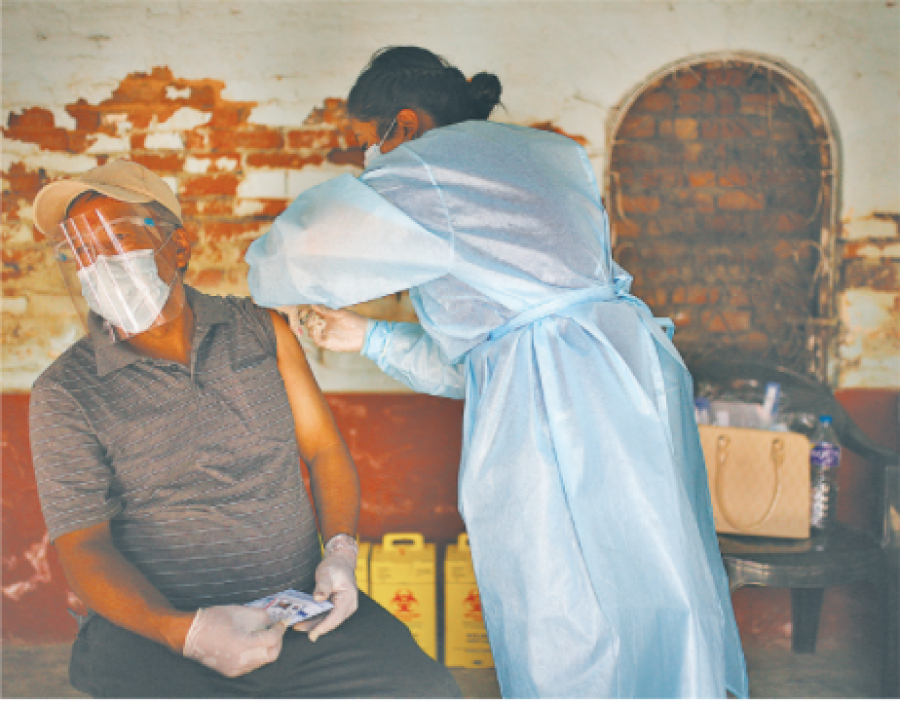Health
Pressure from all sides for jabs, but there is no sign of vaccine arrival
Officials say there has been pressure on health workers across the country to give the Covid-19 jabs to friends and family members of influential people.
Arjun Poudel
The ongoing Covid-19 immunisation programme in Kathmandu restarted on Monday after a suspension of three days.
“The number of people seeking immunisation is so huge that we had to pause the immunisation for a few days,” Rupa Budathoki, coordinator of immunisation programmes at the District Health Office, told the Post.
Kathmandu Metropolitan City had returned 6,000 doses to the Health Office, Kathmandu (previously known as District Public Health Office) last week after it could not withstand the pressure of people seeking vaccination.
The situation arose because of the authorities’ failure to ensure fair and equitable administration of vaccines, according to experts.
“It has been reported that clever and influential people have been getting jabs for themselves and for their people,” Dr Sharad Onta, a public health expert. “We had foreseen this and had been raising concern about equitable distribution of the vaccine before it was brought into the country.”
Government officials too concede this is happening across the country.
“Immunisation workers from many districts have complained to us about the problems in the immunisation programme and reported to us about the misuse of the jabs,” Dr Tara Nath Pokhrel, director at the Family Welfare Division, under the Department of the Health Services, told the Post. “Health workers have complained that local government representatives, bureaucrats and politicians are pressuring them to provide vaccines to their people, who are not in the priority group.”
Immunisation centres had been set up in all 32 wards of Kathmandu Metropolitan City last week. On Monday, however, jabs were administered only at four major hospitals—Bir Hospital, Tribhuvan University Teaching Hospital, Army Hospital and Civil Hospital—on Monday. The vaccination will continue until Tuesday.
“We held discussion with the chief district officer and decided to provide the vaccine only from four major hospitals,” said Budhathoki of the Health Office, Kathmandu. “This measure was taken to avoid the pressure from various groups including politicians, bureaucrats, media persons and others to provide jabs to their people.”
The Ministry of Health and Population started immunisation against Covid-19 with the vaccine provided by China under grant assistance throughout the country from Tuesday last week. People between 60 to 64 were selected as a priority group, which was changed in the last hour and authorities decided to provide jabs to the said age group only in Kathmandu Valley. Outside the Valley, only those between 62 and 64 years were administered with the vaccine.
According to the authorities, if there are problems in the field in administering the vaccine, then it is not because of the policy. They claim that the Health Ministry has prepared vaccination protocols and sent them to the provincial and local government agencies with clear mention of the priority groups.
“There are no problems in the vaccine deployment plan,” Dr Shyam Raj Upreti, coordinator of the Covid-19 Vaccine Advisory Committee, told the Post. “The deployment plan was prepared to administer the vaccine as per the priority list and authorities must follow the deployment plan.”
The problem has arisen because of a lack of clarity on when the next lot of the vaccine will arrive, experts say.
“Vaccine is the most cost-effective means to get rid of infections,” Dr Biraj Karmacharya, an epidemiologist, told the Post. “Authorities should not wait to get a donation discount to save one billion while purchasing the vaccine.”
But the government is nowhere close to securing any vaccine deal, according to an official at the Department of Health Services.
“Attempts are being made to buy the jabs from several countries but it has not reached the phase to sign an agreement,” said the official on condition of anonymity.
So far, 691,494 people or around 2.3 percent of the total population have been fully vaccinated with both doses. Similarly, 2,422,376 others have received at least one dose of vaccines given in grants by China, India and the COVAX facility as well as the 1 million doses bought from India, according to the Health Ministry.
Some 1.4 million people aged over 65 are waiting to get the second dose but when the vaccines will arrive is unclear.
Officials say that the government has been trying its best to secure a deal to procure vaccines at the earliest. According to them, diplomatic notes have been sent to many vaccine-producing countries and several rounds of talks have been held with representatives of some vaccine manufacturers.
The government has mobilised diplomatic missions in many countries to secure vaccine deals but to no avail.
“Unless a deal is signed and the vaccine is delivered, it will not have much meaning about what we did,” Dr Baburam Marasini, former director at the Epidemiology and Disease Control Division, told the Post. “Only talks and exchange of letters doesn't help to make people secure and contain the spread of infections.”
With no signs of when the vaccines will be procured, the government has so far resorted to imposing lockdowns to control the spread of infections.
On Sunday, authorities in Kathmandu Valley announced that the ongoing lockdown, which began on April 29, would continue for one more week. Many other districts will copy the decision of the authorities of Kathmandu Valley, as they do not see other options, except containing people inside their homes.
But given the experience of other countries like the US and Israel which have opened up, vaccines are the only way out of the pandemic.
“Without immunising the maximum number of people, coronavirus infections cannot be contained,” Dr Krishnaman Shakya, vice-president of Nepal Public Health Association, told the Post. “Authorities concerned should make every effort to bring vaccines and correct the mistakes happening in the immunisation programme.”



 17.12°C Kathmandu
17.12°C Kathmandu














